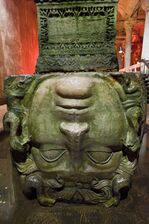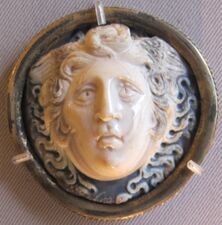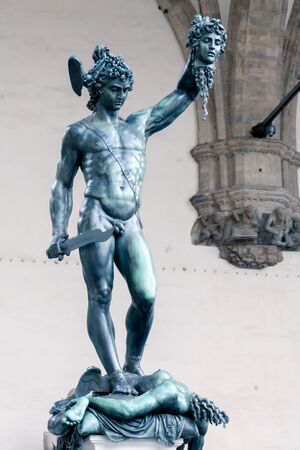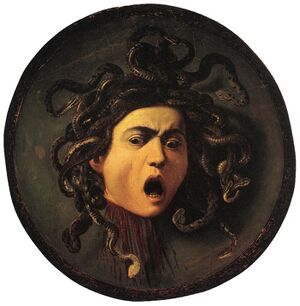مدوسا
| Medusa | |
|---|---|
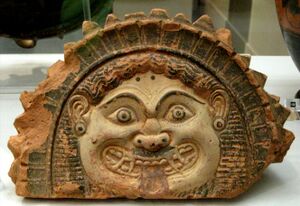 Classical Greek gorgoneion featuring the head of Medusa; fourth century BC | |
| معلومات شخصية | |
| الأبوان | Phorcys and Ceto |
| الأشقاء | The Hesperides, Stheno, Euryale, The Graeae, Thoosa, Scylla, and Ladon |
| القرين | Poseidon |
| الأنجال | Pegasus and Chrysaor |
| الأساطير اليونانية |
|---|
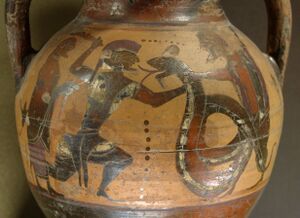 |
| الآلهة |
| الأبطال والبطولة |
| متعلقات |
ميدوسا أو ميدوزا أو ماتيس
ميدوسا كانت في البدء بنتا جميلة، غير أنها مارست الجنس مع بوسيدون في معبد آثينا وهذا ماجعل آثينا تغضب، فحولتها إلى امرأة بشعة المظهر كما حولت شعرها إلى ثعابين وكان كل من ينظر إلى عينيها يتحول إلى حجر. وبما أن ميدوسا كانت قابلة للموت فقد تمكن برسيوس بمساعدة هرمس، حسب الميثولوجيا الإغريقية من القضاء عليها وقطع رأسها لما نظر إلى صورة انعكاسها في درع آثينا، وأهدى رأسها لآثينا التي كانت قد ساعدته وقامت بوضعه على درعها المسمى بالأيغيس. أنجبت ميدوزا من بوسيدون طفلين.
According to Hesiod and Aeschylus, she lived and died on Sarpedon, somewhere near Cisthene. The 2nd-century BC novelist Dionysios Skytobrachion puts her somewhere in Libya, where Herodotus had said the Berbers originated her myth as part of their religion.
الأسطورة

نشأتها
ميدوسا هي بنت بورسيوس (إله البحر) - أبن الجبارين جايا وبونتوس - وسيتو (وحش البحر) أخته وزوجته فيما بعد, كان لها أختين : سثينو وإوريال,
كان الثلاث إخوات يعيشنّ في ما وراء حافة العالم حيث الشمس والقمر لا يصلانها و كان يطلق عليهن جورجونز بمعنى المرعبات، كان هناك العديد من الافتراضيات حول تحويل الأخوات الثلات إلى جورجونيات ومنها:
1- أن ميدوسا إدعت أنها أجمل من أثينا.
2- أن ميدوساأدعت أن شعرها أجمل من شعر أثينا.
3- أنها مارست الجنس من بوسيدون (إله البحر) في معبد أثينا (إما أنه إعتصبها أو أنها خضعت له).
ولكن الافتراضية الثالثة هي الأكثر انتشارًا وأعتقد أكثرها منطقية, حيث أن الأخوات الثلات كُنَّ شديدات الجمال, و كُنَّ كاهنات في معبد أثينا ولكن بعد أن مارست ميدوسا الجنس مع بوسيدون غضبت وحولتهن إلى وحوش, قيل أن أثينا تركت ميدوسا بوجهها الطبيعى دون قناع الجورجونيات المرعب، لتتمكن من إغواء الرجال وتحويلهم إلى أحجار
موتها
لعب بيرسيوس الدور الرئيسى في أسطورة ميدوسا حيث واجه الموت لكى يقتلها, ولكن كان لايد أن يمتلك أربع أدوات بدونها لايستطبع إتمام ذلك، وهى:
1- سيف قوى وحاد بالدرجة الكافية لكى يقتلها من ضربة واحدة حتى لا تتمكن من القيام وإيقاعه في مصيدتها.
2- حذاء هرمس الذي يستطيع بواستطه الطيران.
3- خوذة هادس التي تغمره بالظلام كى لا تراه الأخوات أثناء دخوله وخروجه.
4- الحقيبة التي يحمل فيها رأسها بحيث لا توذه ولا أحد آخر من قوة عينيها.
رأى بيرسيوس انعكاس ميدوسا من خلال درعه وهى لم تستطه رؤيته بفضل الخوذة فباغتها بضربة قطعت رأسها
أبناؤها
أنه الحصان المجنح الذي أصبح سيده بيرسيوس فيما بعد وهناك اختلافات في كيفية ظهوره لكن الأكثر تداولاً, هو أنه عندما قطع بيرسيوس رأس ميدوسا تكون بيجاسوس من دمها المتدفق، ولو لاحظنا فإنها نفس كيفية انبثاق أثينا من رأس زيوس.
أخ بيجاسوس ويصور بخنزير مجنح ضخم، وأنه ظهر من جسد ميدوسا بعد أن قُطِع رأسها على عكس بيجاسوس الذي تكون من دمها.
Some classical references refer to three Gorgons; Harrison considered that the tripling of Medusa into a trio of sisters was a secondary feature in the myth:
The triple form is not primitive, it is merely an instance of a general tendency... which makes of each woman goddess a trinity, which has given us the Horae, the Charites, the Semnai, and a host of other triple groups. It is immediately obvious that the Gorgons are not really three but one + two. The two unslain sisters are mere appendages due to custom; the real Gorgon is Medusa.[1]
An ancient Roman carving of the Medusa, now a spolia in use as a column base in the Basilica Cistern
The Medusa's head central to a mosaic floor in a tepidarium of the Roman era. Museum of Sousse, Tunisia
Aplique with the shape of Medusa discovered in Ulpia Traiana Sarmizegetusa
في الفن
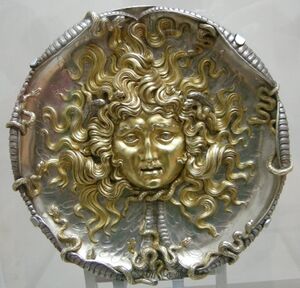
Medusa has been depicted in several works of art, including:
- Perseus beheading the sleeping Medusa, obverse of a terracotta pelike (jar) attributed to Polygnotos (vase painter) (c. 450–440 BC), collection of the Metropolitan Museum of Art
- Medusa on the breastplate of Alexander the Great, as depicted in the Alexander Mosaic from Pompeii's House of the Faun (c. 200 BC)
- Medusa column bases of Basilica Cistern in Constantinople.
- The "Rondanini Medusa", a Roman copy of the Gorgoneion on the aegis of Athena; later used as a model for the Gorgon's head in Antonio Canova's marble Perseus with the Head of Medusa (1798–1801)
- Medusa (oil on canvas) by Leonardo da Vinci
- Perseus with the Head of Medusa (bronze sculpture) by Benvenuto Cellini (1554)
- Perseus and Medusa – bronze statue by Hubert Gerhard (c. 1590)
- Medusa (oil on canvas) by Caravaggio (1597)
- Head of Medusa, by Peter Paul Rubens (1618)
- Medusa (marble bust) by Gianlorenzo Bernini (1630s)
- Medusa is played by a countertenor in Jean-Baptiste Lully and Philippe Quinault's opera, Persée (1682). She sings the aria "J'ay perdu la beauté qui me rendit si vaine" ("I have lost the beauty that made me so vain").
- Perseus Turning Phineus and his Followers to Stone (oil on canvas) by Luca Giordano (early 1680s).
- Perseus with the Head of Medusa (marble sculpture) by Antonio Canova (1801)
- Medusa (1854), marble sculpture by Harriet Hosmer, collection of the Detroit Institute of Art
- Medusa (oil on canvas) by Arnold Böcklin (c. 1878)
- Perseus (bronze sculpture) by Salvador Dalí
- Medusa sculpture by Luciano Garbati, which portrays her clutching the severed head of Perseus (2008)[2]
Medusa remained a common theme in art in the nineteenth century, when her myth was retold in Thomas Bulfinch's Mythology. Edward Burne-Jones' Perseus Cycle of paintings and a drawing by Aubrey Beardsley gave way to the twentieth-century works of Paul Klee, John Singer Sargent, Pablo Picasso, Pierre et Gilles, and Auguste Rodin's bronze sculpture The Gates of Hell.[3]
Flags and emblems
The head of Medusa is featured on some regional symbols. One example is that of the flag and emblem of Sicily, together with the three-legged trinacria. The inclusion of Medusa in the center implies the protection of the goddess Athena, who wore the Gorgon's likeness on her aegis, as said above. Another example is the coat of arms of Dohalice village in the Czech Republic.
Municipal coat of arms of Dohalice village, Hradec Králové District, Czech Republic
Ceremonial French military uniform belt of World War I
Medusa image in a historical caricature of the Reign of Terror during the French Revolution
في العلوم
Medusa is honored in the following scientific names:[4]
- Acanthemblemaria medusa Smith-Vaniz & Palacio 1974
- Apodochondria medusae Ho & Dojiri 1988
- Archimonocelis medusa Curini-Galletti & Cannon 1997
- Atractus medusa Passos et al. 2009[5]
- Australomedusa Russell 1970
- Boeromedusa Bouillon 1995
- Bothrops medusa Sternfeld 1920[5]
- Cardiodectes medusaeus Wilson C.B. 1908
- Chama oomedusae Matsukuma 1996
- Cirratulus medusa Johnston 1833
- Coronamedusae
- Csiromedusa Gershwin & Zeidler 2010
- Csiromedusa medeopolis Gershwin & Zeidler 2010
- Discomedusa lobata Claus 1877
- Discomedusae
- Eustomias medusa Gibbs, Clarke & Gomon 1983
- Gorgonocephalus caputmedusae L. 1758
- Gyrocotyle medusarum von Linstow 1903 (taxon inquirendum)
- Halimedusa Bigelow 1916
- Halimedusa typus Bigelow 1916
- Heteronema medusae Skvortzov 1957
- Hoplopleon medusarum K.H. Barnard 1932
- Hyperia medusarum Müller 1776
- Hyperoche medusarum Krøyer 1838
- Leptogorgia medusa Bayer 1952
- Lilyopsis medusa Metschnikoff & Metschnikoff 1871
- Limnomedusae
- Loimia medusa Savigny in Lamarck 1818
- Loimia medusa angustescutata Willey 1905
- Lulworthia medusa (Ellis & Everh.) Cribb & J.W. Cribb 1955
- Lulworthia medusa var. biscaynia Meyers 1957
- Lulworthia medusa var. medusa (Ellis & Everh.) Cribb & J.W. Cribb 1955
- Magnippe caputmedusae Stock 1978
- Medusa Loureiro 1790
- Medusablennius Springer 1966
- Medusaceratops Ryan, Russell & Hartman 2010
- Medusafissurella McLean & Kilburn 1986
- Medusafissurella chemnitzii G. B. Sowerby I 1835
- Medusafissurella dubia Reeve 1849
- Medusafissurella melvilli G. B. Sowerby III 1882
- Medusafissurella salebrosa Reeve 1850
- Mesacanthoides caputmedusae (Ditlevsen 1918) Wieser 1959
- Myxaster medusa Fisher 1913
- Narcomedusae
- Ophioplinthus medusa Lyman 1878
- Phallomedusa Golding, Ponder & Byrne 2007
- Phallomedusa austrina Golding, Ponder & Byrne 2007
- Phallomedusa solida Martens 1878
- Phascolion medusae Cutler & Cutler 1980
- Philomedusa
- Philomedusa vogtii Müller 1860
- Polycirrus medusa Grube 1850
- Polycirrus medusa sakhalinensis Buzhinskaja 1988
- Sarcomella medusa Schmidt 1868
- Stauromedusae
- Stellamedusa Raskoff & Matsumoto 2004
- Stellamedusa ventana Raskoff & Matsumoto 2004
- Stygiomedusa Russell 1959
- Stygiomedusa gigantea Browne 1910
- Thylacodes medusae Pilsbry 1891
- Trachymedusae
في الثقافة الشعبية
انظر أيضاً
- Apotropaic symbols
- Caput Medusae - [Head of Medusa] (disambiguation article)
- Cassandra
- Comaetho
- Humbaba
- Medea
- Medusa complex
- Nāga
- Shahmaran
- Theodontius
- Tiamat
ملاحظات
المراجع
- ^ خطأ استشهاد: وسم
<ref>غير صحيح؛ لا نص تم توفيره للمراجع المسماةHarrison - ^ "Luciano Garbati's Medusa". Luciano Garbati.
- ^ Wilk 2000, p. 200.
- ^ WoRMS Editorial Board (2017). World Register of Marine Species. Available from http://www.marinespecies.org at VLIZ. Accessed 2017-09-06. DOI:10.14284/170
- ^ أ ب Beolens, Bo; Watkins, Michael; Grayson, Michael (2011). "Medusa", p. 175 in The Eponym Dictionary of Reptiles. Baltimore: Johns Hopkins University Press. ISBN 978-1-4214-0135-5.
روابط خارجية
- http://www.arthistory.sbc.edu/imageswomen/papers/kottkegorgon/gorgons.html
- Ancient coins depicting Medusa
- "Medusa in Myth and Literary History" – English.uiuc.edu Archived 2008-12-18 at the Wayback Machine
- Theoi Project, Medousa & the Gorgones References to Medusa and her sisters in classical literature and art
- The Warburg Institute Iconographic Database (images of Medusa)
- Articles with hatnote templates targeting a nonexistent page
- Missing redirects
- Short description is different from Wikidata
- Articles having different image on Wikidata and Wikipedia
- Portal-inline template with redlinked portals
- Pages with empty portal template
- Medusa
- Gorgons
- Decapitation
- Deeds of Athena
- Heraldic beasts
- Libyan characters in Greek mythology
- Metamorphoses characters
- Metamorphoses into monsters in Greek mythology
- Mythological rape victims
- Women and death
- Women in Greek mythology
- Snakes in popular culture
- أساطير يونانية

